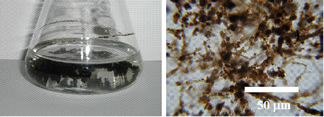Environmental Microbiology

- account_circleYukinori TaniPhD, Prof.
- account_circleKazuhiro UmezawaPhD, Research Asst. Prof.
- Website:https://dfns.u-shizuoka-ken.ac.jp/labs/emb/
- Mail:taniy@u-shizuoka-ken.ac.jp
- Phone:+81-54-264-5797
Investigating the rules governing microorganism use in biogeochemistry and ecology
Application of microbial functions for environmental protection
- 1. Developing new biotechnologies for environmental protection and sustainable development using microorganisms
Clean and safe water availability is a prerequisite for maintaining human health, the production of safe foods, as well as the development a sustainable society. However, the availability of safe water is abruptly decreasing worldwide because of the demand for an excessive amount of water and the decline of water resources. Thus, a highly efficient technology to clean water is needed. For this purpose, we are focusing on the development of a cost-effective treatment system to remove chemical contaminants from wastewaters using “Mn(II)-oxidizing” fungi that form insoluble Mn(IV)-oxide nanoparticles. Biogenic Mn oxides (BMOs) enzymatically formed by the fungi (Fig. 1) possess unique characteristics such as high surface area and a large amount of structural vacancy. As a consequence, BMOs serve as potent sequestering materials for various inorganic elements, especially heavy metal ions. Since BMOs display very high sequestrating capacity for heavy metal ions (more than 20% by molar ratio), the resultant BMOs following heavy metal ion sequestration can be regarded as “ores” of the corresponding metals. BMOs also have a strong ability to oxidize inorganic molecules (e.g., As(III), which is converted to As(V)) and organic compounds. Therefore, they are potentially valuable in the elimination of contaminants from water resources.
- 2. Research on microorganism assemblage in lakes and lagoon systems
Microorganism assemblages accurately reflect the environments in which they live. Coastal areas, lagoons, lakes, and rivers are important areas for the production of fisheries to provide healthy food for people. However, the conditions of these aquatic environments have declined dramatically due to increasing human activity in the watershed. The development of hypoxia and anoxia is one of the most severe consequences, threating fish production worldwide. We are monitoring phytoplankton, phototrophic bacteria, as well as other autotrophic and heterotrophic bacteria in saline or brackish lakes (Lake Hamana, Lake Sanaru, Lake Shinji-ko, and Lake Naka-umi) in relation to trophic levels of the lake and other hydrological factors (Fig. 2). We are particularly interested in microorganism assemblage in hyper-eutrophic lakes and its impact on the food web.
- 3. A paleoecological approach to microorganism assemblage
Tracking past environmental conditions using sediment core records can provide important knowledge about long-term environmental changes that have been caused by natural and/or anthropogenic events. For this purpose, we have collected undisturbed cores from the bottom of lakes and coastal areas, and measured the downcore profiles of specific “bio-markers” to reconstruct environmental changes over large periods of time. We have demonstrated that sedimentary pigments (chlorophyll and its derivatives, bacteriochlorophylls, and carotenoids) derived from various phototrophs are useful “bio-markers” to track environmental changes such as the trophic level and the development of anoxia in lakes. Lake Baikal (Russia), Lake Hovsgol (Mongolia), and Lake Hamana (Japan) are our research fields.
- Figure 1
- Manganese (II) oxidizing fungus, Acremonium structum KR21-2, producing highly reactive manganese oxide nanoparticles.

- Figure 2
- Summer bloom of picocyanobacteria, Synechococcus sp. in a eutrophic brackish lake (Lake Sanaru, Shizuoka, Japan)

References
- Quat. Int. 205, 74-83(2009).
- Quat. Int. 205, 126-136 (2009).
- Chem. Geol., 306-307, 123-128 (2012).
- Chem. Geol., 347, 227-232 (2013).
- Appl. Geochem., 37, 170-178 (2013).